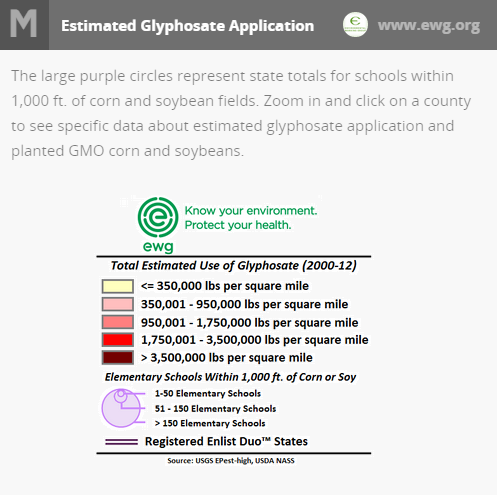3,247 Elementary Schools are Exposed to Monsanto’s Toxic Weed Killer
3,247 Elementary Schools are Exposed to Monsanto’s Toxic Weed Killer
Should children be so close to pesticides?
Is your child one of the thousands of children being exposed regularly to Monsanto’s toxic glyphosate, recently called “probably carcinogenic” by the World Health Organization?
Considering that GMO corn and soybeans are planted just about everywhere and they were created to withstand egregious amounts of toxic herbicidal spraying with Monsanto’s favorite product, Round Up, the answer to the question is likely yes. There’s no reason to guess about it though.
The Environmental Working Group (EWG) has releasedan interactive map that shows the amounts of glyphosate sprayed in each U.S. county and tallies the 3,247 elementary schools that are located within 1,000 feet of a GM corn or soybean field as well as the 487 schools that are within 200 feet of toxic glyphosate.
You can click on any county on the map (via the EWG resource, not the image below) to see how much GMO corn and soy acreage is grown in an area, as well as the number of nearby elementary schools. Does your child attend one?
Thousands of children attend these schools that are mere feet away from a known cancer-causing agent. If you think fields blanketed in these chemicals is safe – just wait another decade and watch the number of autism, childhood cancer, reproductive problems, and gut devastation cases absolutely explode.
What’s worse is that glyphosate has given rise to a whole additional class of herbicides since it didn’t do the job it was so heavily marketed to do. Superweeds are now taking overthe American Midwest, and elsewhere.
There are also 15 states outlined on the EWG’s map, running through the center of the country, that the US Environmental Protection Agency (EPA) has approved to be sprayed with Dow AgroSciences’ Enlist Duo – a combination of glyphosate and 2,4-D. This toxic pesticide is sprayed on GMO corn and soybeans engineered to tolerate both toxic chemicals, marketed as weed killers.
Meanwhile, retail giants have decided to remove all glyphosate-containing productsfrom their stores.
Just ten states account for 53 percent of the total acreage planted with GMO corn and soy, but no state is safe as long as Monsanto, Dow, Syngenta, and Bayer are allowed to call the shots.
“Methodology:
EWG approximated school locations using the ESRI ( www.esri.com) landmark shape file for schools, derived from the U.S. Geological Survey Geographic Names Information System – Schools layer. These are considered the best available data for school locations. The data were filtered to the best of EWG’s knowledge to include only locations whose attributed name reflects an operating elementary school, but they may inadvertently include some free-standing school administrative offices or buildings that formerly housed schools but are now in other use.
Zones within 200 feet and 1,000 feet of each school were delineated using the school’s point location in the ESRI data, not the physical footprint of the school grounds. As a result, EWG’s analysis may over- or under-estimate the exact distance of school grounds to the boundaries of nearby corn or soybean fields. School locations were evaluated for proximity to the boundaries of corn and soybean fields as delineated in the USDA 2013 cropland data layer (30-meter resolution).
EWG acknowledges that spatial analyses of this kind may include some level of error (such as incorrect or outdated school or crop field locations or boundaries) even with standard, best available data sources. EWG welcomes information to revise and correct any locational errors in the underlying data.
Data on estimated glyphosate use was drawn from the U.S. Geological Survey’s Estimated Annual Agricultural Pesticide Use for Counties of the Conterminous United States (2008-2012 & 1992-2009). According to the USGS, “ Pesticide use estimatesfrom this study are suitable for making national, regional, and watershed assessments of annual pesticide use, however the reliability of estimates generally decreases with scale.”
Data on the acreage of genetically modified corn and soybeans were assembled by extrapolating from county-planted acreage using state percentages of biotech varieties by crop, as reported by the USDA. For corn, state level “herbicide resistant” + “stacked gene” varieties were used to extrapolate county-level planted acreage. If a state was not specifically listed in the USDA NASS Acreage Report, the category “Other” was used in the extrapolation. For soybeans, the state-level “all biotech varieties” was used to extrapolate planted acres at the county level. If a state was not specifically listed in the USDA NASS Acreage Report, the category “Other” was used in the county extrapolation.”
| About Christina Sarich: | |
| Christina Sarich is a humanitarian and freelance writer helping you to Wake up Your Sleepy Little Head, and See the Big Picture. Her blog is Yoga for the New World. Her latest book is Pharma Sutra: Healing the Body And Mind Through the Art of Yoga. | |
Other Popular Stories:


Post a Comment